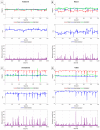Comparison of Cervical Spine Kinematics and Clinical Neck Symptoms Between Mobile Device and Desktop Computer Use
- PMID: 40096247
- PMCID: PMC11902463
- DOI: 10.3390/s25051438
Comparison of Cervical Spine Kinematics and Clinical Neck Symptoms Between Mobile Device and Desktop Computer Use
Abstract
The widespread use of mobile devices and desktop computers has been associated with mechanical neck symptoms, yet few studies have compared cervical kinematics and clinical symptoms between them. In this study, 15 participants (27.7 ± 4.4 years, 12 male) performed four randomly ordered 20 min tasks: two mobile (smartphone and tablet) and two desktop computer (keyboard and mouse) tasks. Kinematic variables, including neck flexion, lateral bending, axial rotation, anterior translation, and total distance moved, were measured using an optical motion capture system, while clinical symptoms, including discomfort, pain, tension, and fatigue, were assessed using a visual analog scale. Paired t-tests and linear mixed models were used for analysis. Results showed that mobile device users exhibited greater neck flexion (38.9° [32.1-45.6°] vs. -0.2° [-4.3-3.9°], p < 0.001) and anterior translation (21.0 cm [12.0-30.1] vs. 1.6 cm [-4.4-7.7], p < 0.001) compared to desktop users. All clinical symptoms were significantly higher during mobile device use (p < 0.05), with neck flexion and anterior translation strongly correlating with symptom severity. In conclusion, mobile device use leads to more severe neck symptoms compared to desktop computer use, which is associated with increased flexion and forward head posture. To reduce neck symptoms, avoiding sustained flexion and forward head positions during mobile device use is recommended.
Keywords: desktop computer; kinematics; mobile device; neck pain.
Conflict of interest statement
The authors declare that they have no competing interest.
Figures



Similar articles
-
Intervertebral kinematics of the cervical spine before, during, and after high-velocity low-amplitude manipulation.Spine J. 2018 Dec;18(12):2333-2342. doi: 10.1016/j.spinee.2018.07.026. Epub 2018 Aug 22. Spine J. 2018. PMID: 30142458
-
Gender difference in mobile phone use and the impact of digital device exposure on neck posture.Ergonomics. 2016 Nov;59(11):1453-1461. doi: 10.1080/00140139.2016.1147614. Epub 2016 Apr 5. Ergonomics. 2016. PMID: 27046745
-
The impact of neck pain and movement performance on the interarticular compressive force of the cervical spine: a cross-sectional study based on OpenSim.J Neuroeng Rehabil. 2025 Feb 11;22(1):26. doi: 10.1186/s12984-025-01559-2. J Neuroeng Rehabil. 2025. PMID: 39934818 Free PMC article.
-
Differences in the kinematics of the cervical and thoracic spine during functional movement in individuals with or without chronic neck pain: a systematic review.Physiotherapy. 2019 Dec;105(4):421-433. doi: 10.1016/j.physio.2019.01.007. Epub 2019 Jan 21. Physiotherapy. 2019. PMID: 31005251
-
Ocular and visual discomfort associated with smartphones, tablets and computers: what we do and do not know.Clin Exp Optom. 2019 Sep;102(5):463-477. doi: 10.1111/cxo.12851. Epub 2019 Jan 21. Clin Exp Optom. 2019. PMID: 30663136 Review.
References
Publication types
MeSH terms
LinkOut - more resources
Full Text Sources
Medical

